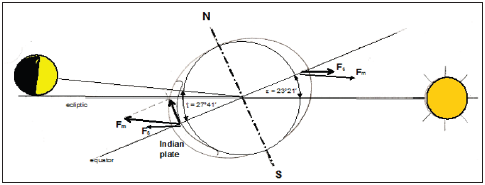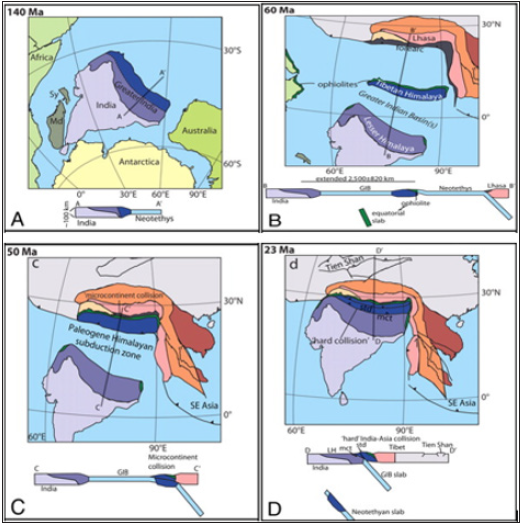- Submissions

Full Text
Archaeology & Anthropology:Open Access
Collision Between India and Asia In Light of Action of Tides
Ostřihanský L*
Nad Palatou 7, Czech Republic
*Corresponding author: Ostřihanský L, Nad Palatou 7, Czech Republic
Submission: February 23, 2021Published: March 30, 2021

ISSN: 2577-1949 Volume4 Issue2
Abstract
Coming from detailed investigation of van Hinsbergen et al. [1] about two-stage Cenozoic collision between India and Asia, the author presents proof that such collision is possible only by action of tidal forces. Considering tidal torque 1022Nm, this torque can move lithospheric plate as far as the plate exceeds equator and if subduction zone is in front of it. Moving Gondwana southward had subduction zone on south but created subduction zone in Cenozoic in Laurasia or later in Asia on north, had created reversed plate movement northward and pushed extinct mid-ocean ridge to component of Himalayan Mountain Belt.
Introduction
In 2012 van Hinsbergen et al. [1] presented detailed description of India and Asia collision. Their investigation is based on paleomagnetic data and position of plates constructing Euler’s poles. These constructions lead to imagination of hypothetical convection currants in mantle [2], comprising the whole mantle or only small currants of shallow depth. Tides act on the earth preferably in north-south direction pulling equatorial bulging, which was created by earth rotation (Figure 1). Less important is westward drift created by tidal friction. The mechanism of tides acting on plates uses equator-fleeing force [3], which pushes away plates situated on equator to north or south depending on whether the plate exceeds equator and is released for northward or southward movement. It means that in case of oceanic lithosphere the plate subducts or in case of continental lithosphere subduction zone is in front of it.
In Lower Tertiary separation of Gondwana from Laurasia continued crossing equator by equator fleeing tidal force 1022Nm [3] using ratcheting mechanism preventing movement northward but subducting old oceanic lithosphere in front of Gondwana on south facilitated the movement southward, pushing Gondwana far south over south pole. Witness of that movement is Transantarctic Mountain Range and mid-ocean ridge situated in middle of ocean between Gondwana and Laurasia, which remained as fossil ridge. In mantle convection hypothesis [2] mid-ocean ridges have fixed position in mantle. However tidal forces cause that mid-ocean ridges move and mid–ocean ridge, which moved with 1/2 speed of Gondwana remained as fossil ridge in Neotethys Ocean, in van Hinsbergen et al. [1] called later as Tibetan Himalayan microcontinent.
Figure 1: Tidal torque acting on equatorial rotational flattening causing movement of Indian plate northward towards subduction zone in Eurasian plate shore. Maximum declinations of Moon and Sun during Full Moon and winter solstice caused maximum torque 1022 Nm (3,4).

140Ma ago (Figure 2), taken with permission from Hinsbergen et al. [1], large oceanic plate has been created comprising Neotectonic Ocean as far as subduction zone in font of Asia and with small continent Greater India on rear side. This part has been torn off Gondwana by tidal force because this plate exceeded far equator and subducting oceanic lithosphere in front of this plate made this movement northward possible. It is therefore evident that subduction zone existed from the beginning and not in Paleogene as Figure 2. Figure 2 shows consumption of Neotethys oceanic lithosphere and formation of forearc volcanism in Lhasa.
Figure 2 shows collision of fossil mid-ocean ridge later called Tibetan Himalayas containing ophiolites as representatives of former mid-ocean volcanism. These volcanites can never subduct because are too light and always form obduction. (See similar form of obduction in Taiwan in [4] (Figure 2). Figure 2 shows final hard collision of Indian lithosphere and subducting of oceanic lithosphere of Greater Indian Basin forming the main central thrust in front of South Tibetan detachment.
Figure 2: Plate reconstruction of the India-Asia collision (1). A small Greater India (A) was extended in the Cretaceous (B), where ophiolites mark position of extinct mid-ocean ridge created in Gondwana northward movement. (C) “soft” collision and ongoing subduction around 50Ma and ophiolites become component of Himalayas. (D) a “hard” collision with thick, continuous Indian lithosphere between 25 and 20Ma. MCT, main central thrust; Md, Madagascar; STD, South Tibetan detachment; Sy, Seychelles (remnant of the plate movement).

Conclusion
Paper presents proof that Himalaya’s mountain belt has been performed by collision of plate driven by tidal force. Acting tides show how easily can be explained the movement of plate, first southward and shortly after northward by tides. In mantle convection hypothesis [2] such change, and reversed movement is impossible. Similarly, is impossible to move northward the whole convection cell with fixed mid-ocean ridge above. In case of tidal driven plate, the plate can subduct in different sites, in Himalayas and in SE Asia in front of Indonesia simultaneously. Most important is the tidal equator-fleeing force and ratcheting mechanism which prevents movement against mid-ocean ridge and strong push of torque 1022Nm forward to subduction zone in diurnal variation and with enlargement in nodal 18.6 days variation [3,4].
So, it is possible to observe: The plate southward movement creating mid-ocean ridge in middle between Laurasia and Gondwana. Then creating Himalaya mountain belt by northward movement of oceanic plate with Indian craton behind and by subduction of Neotectonic Ocean carrying fossil mid-ocean ridge, manifested after collision by ophiolites, finally subduction of Grater Indian Basin forming concluding collision.
References
- Douwe JJVH, Peter CL, Guillaume DN, Nadine MQ, Pavel VD, et al. (2012) Greater india basin hypothesis and a two-stage cenozoic collision between india and asia. Proc Natl Acad Sci USA 109(20): 7659-7664.
- Schubert G, Turkotte DL, Olson P (2004) Mantle convection in earth and planets. Cambridge University Press, UK.
- Ostřihanský L (2015) Tides as drivers of plates and criticism of mantle convection. Acta Geodaetica et Geophysica 50(3): 271-293.
- Ostřihanský L (2021) No mantle convection but efficient tidal forces move plates (Corrected). Earth and Space Science Open Archive.
© 2021 Ostřihanský L. This is an open access article distributed under the terms of the Creative Commons Attribution License , which permits unrestricted use, distribution, and build upon your work non-commercially.
 a Creative Commons Attribution 4.0 International License. Based on a work at www.crimsonpublishers.com.
Best viewed in
a Creative Commons Attribution 4.0 International License. Based on a work at www.crimsonpublishers.com.
Best viewed in 







.jpg)






























 Editorial Board Registrations
Editorial Board Registrations Submit your Article
Submit your Article Refer a Friend
Refer a Friend Advertise With Us
Advertise With Us
.jpg)






.jpg)














.bmp)
.jpg)
.png)
.jpg)










.jpg)






.png)

.png)



.png)






